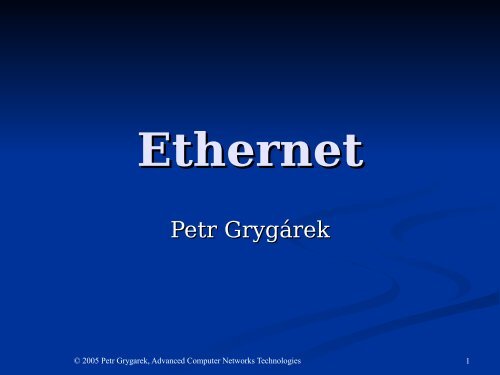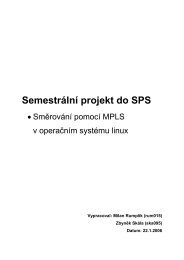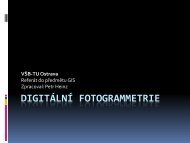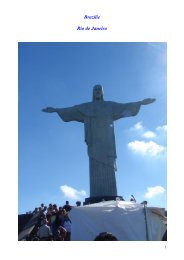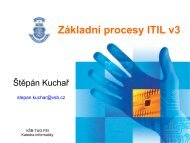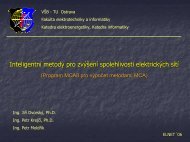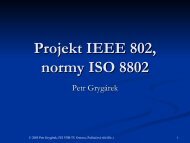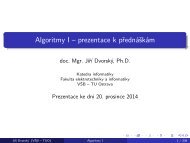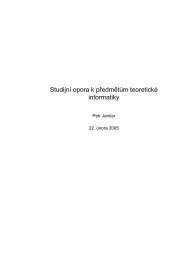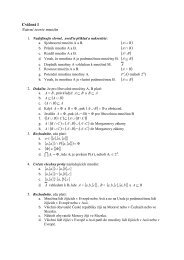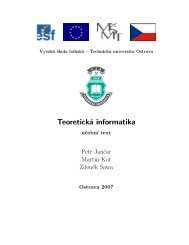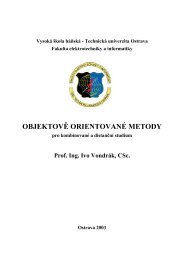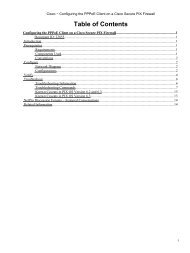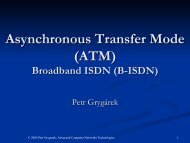Cisco Presentation Guide
Cisco Presentation Guide
Cisco Presentation Guide
You also want an ePaper? Increase the reach of your titles
YUMPU automatically turns print PDFs into web optimized ePapers that Google loves.
Ethernet<br />
Petr Grygárek Gryg rek<br />
© 2005 Petr Grygarek, Advanced Computer Networks Technologies 1
Ethernet History Histor<br />
•Research Research background: AlohaNet<br />
•University University of Hawai, 1970: 1970:<br />
common (radio) channel<br />
sharing methods – basis for CSMA/CD<br />
•1980: 1980: DIX published Ethernet standard<br />
(Metcalfe)<br />
•1985: 1985: IEEE 802.3 802.3<br />
(MAC and LLC layers)<br />
•10Base5, 10Base5, 10Base2, 10BaseT<br />
•1995 1995 IEEE 802.3u (Fast Ethernet)<br />
•1998 1998 IEEE 802.3z (Gigabit Ethernet)<br />
•2002 2002 IEEE 802.3ae (10Gb Ethernet)<br />
•... ...<br />
© 2005 Petr Grygarek, Advanced Computer Networks Technologies<br />
2
Ethernet Naming Rules<br />
(IEEE Standard)<br />
Mbps [Base|Broad] [segment_length<br />
[segment_length_m<br />
_m | -medium] -medium<br />
-T T - Twisted Pair, -F F - Fiber optic, ...<br />
e.g. 10Base5, 10BaseT, 100BaseF<br />
Name of each particular Ethernet<br />
technology defined in individual<br />
supplements supplement of 802.3 standard<br />
•e.g e.g 802.3u, 802.3ab, 802.3z<br />
© 2005 Petr Grygarek, Advanced Computer Networks Technologies<br />
3
Half-duplex and Full-duplex<br />
Ethernet<br />
•Half Half duplex – colission envirnment<br />
(CSMA/CD)<br />
•Full Full duplex - colission-free<br />
(switched) environment<br />
In half-duplex mode we have to adhere CSMA/<br />
CD timing that implies the maximum cable<br />
lengths<br />
For compatibility with half-duplex NICs, P2P<br />
links may also operate in half-duplex mode<br />
© 2009 Petr Grygárek, FEI VŠB-TU Ostrava, Computer Networks (Bc.)<br />
4
Historical Ethernet<br />
Implementations<br />
© 2005 Petr Grygarek, Advanced Computer Networks Technologies<br />
5
10Base5<br />
= Thick Ethernet = DIX Ethernet =<br />
ETHERNET II<br />
© 2009 Petr Grygárek, FEI VŠB-TU Ostrava, Computer Networks (Bc.)<br />
6
10Base5 Capabilities<br />
•Bus Bus (coax) „Yellow Cable“<br />
•50ohm, 50ohm, diameter of 10 mm<br />
•Max Max segment length 500m, terminated<br />
•Max Max 5 segments interconnected by 4 repeaters,<br />
stations may be placed only on 3 segments (5-4-3<br />
rule)<br />
•Max Max 100 stations per segment, minimum distance<br />
of 2.5 m<br />
•Manchester Manchester encoding<br />
•Utilizes Utilizes external transceivers (AUI interface)<br />
•Attached Attached to bus by T-connector or wampire tap<br />
© 2009 Petr Grygárek, FEI VŠB-TU Ostrava, Computer Networks (Bc.)<br />
7
10Base2<br />
= Thin Ethernet = CheaperNet<br />
•bus, bus, coax RG58<br />
•50ohm, 50ohm, diameter of 5 mm)<br />
•Max Max segment length 185m, terminated<br />
•5-4-3 5-4-3 rule<br />
•Max Max 30 stations per segment, minimum<br />
distance 0.5m<br />
•Interconnection: Interconnection: BNC and T<br />
connectors<br />
•Transceiver Transceiver is integrated on the NIC<br />
© 2009 Petr Grygárek, FEI VŠB-TU Ostrava, Computer Networks (Bc.)<br />
8
10BaseT<br />
•Star Star (tree) topology<br />
•2 2 twisted pairs (UTP3) + RJ-45 connectors<br />
•May May operate in full-duplex mode when switches<br />
are applied<br />
•Stations Stations interconnected with hubs<br />
•5-4-(3) 5-4-(3) rule<br />
•max. ax. 512 stations in the whole tree<br />
•Max Max 100m between hub and NIC<br />
•min min 0.6m<br />
•Crossing Crossing of transmitter and receiver<br />
cable pairs<br />
© 2009 Petr Grygárek, FEI VŠB-TU Ostrava, Computer Networks (Bc.)<br />
9
Fast Ethernet (100Mbps)<br />
•IEEE IEEE 802.3u<br />
•Based Based on 10BaseT<br />
•the the same MAC address protocol and<br />
frame format<br />
•NICs NICs are obviously backward compatible with<br />
10BaseT<br />
•Speed Speed autonegotiation capability<br />
•different different line encoding<br />
•Uses Uses UTP5, 100m between network<br />
devices<br />
© 2009 Petr Grygárek, FEI VŠB-TU Ostrava, Computer Networks (Bc.)<br />
10
Physical Layer of Fast<br />
Ethernet<br />
•100BaseTX: 100BaseTX: UTP5, STP – UTP5, max<br />
100m, 4B5B + MLT3, 125 MHz<br />
•100BaseFX: 100BaseFX: FO, max. distance NICNIChub is 200m (because of CSMA/CD)<br />
•Other Other sparsely used options<br />
•Developed Developed for compatibility with older<br />
cablings - 100BaseT2, 100BaseT4<br />
© 2009 Petr Grygárek, FEI VŠB-TU Ostrava, Computer Networks (Bc.)<br />
11
Fast Ethernet Topologies<br />
(half-duplex)<br />
•2 2 directly connected NICs<br />
•Star Star with Class I hub<br />
•Two Two Class II hubs interconnected by line<br />
of maximum 10 m in length<br />
Hub class I and II differ in<br />
•Maximum Maximum allowed signal delay<br />
•Capability Capability of encoding transformation, i.e. the<br />
ability of using different media in a single<br />
collision domain<br />
•e.g. e.g. transformaiton of 100BaseTX to 100BaseT4<br />
© 2009 Petr Grygárek, FEI VŠB-TU Ostrava, Computer Networks (Bc.)<br />
12
Ethernet Today<br />
•Ethernet Ethernet today is a whole family of<br />
networking technologies (100Mbps+)<br />
•LAN, LAN, MAN, WAN<br />
•Compatibility Compatibility still maintained<br />
© 2005 Petr Grygarek, Advanced Computer Networks Technologies<br />
13
Gigabit Ethernet (802.3z)<br />
•Developed Developed since 1995, originally supposed<br />
to require fiber optic or coax cable,<br />
standard later extended for twisted pair<br />
•802.3ab 802.3ab – compatible with existing wirings<br />
(Cat5e)<br />
•Makes Makes the standard Ethernet faster again<br />
• CSMA or switching, IEEE 802.3 frame, simple<br />
star topology<br />
•Problems Problems with minimum frame length in<br />
collision-mode when trying to keep the<br />
same maximum cable lengths as with<br />
10BaseT<br />
•Appends Appends a padding to 512B into a frame if<br />
necessary or applies packet bursting.<br />
• Most commonly used for backbone links<br />
© 2009 Petr Grygárek, FEI VŠB-TU Ostrava, Computer Networks (Bc.)<br />
14
Physical Layer of the Gigabit<br />
• 1000Base-T: UTP5e<br />
Ethernet<br />
• All 4 pairs used simultaneously in both directions<br />
(PAM5, echo cancellation), max. 100m<br />
• Problems with reflections connectors (the cabling<br />
system may start to resonate)<br />
• 1000Base-SX (short wavelength-850 nm) – used<br />
more often<br />
• 8B10B encoding<br />
• 62.5 um MMF 440m, 50 um MMF 550m<br />
• 1000Base-LX (long wavelength-1300 nm)<br />
• 8B10B encoding<br />
• SMF 3 km, 62.5 um MMF 440m, 50 um MMF 550m.<br />
• Usage of „offsets“ to limit transversal modes on MMF<br />
(decreases dispersion)<br />
• ANSI Fibre Channel<br />
• Supports bandwidths of 133Mpbs to 1Gbps on various<br />
cable types (MMF, STP, coax)<br />
© 2009 Petr Grygárek, FEI VŠB-TU Ostrava, Computer Networks (Bc.)<br />
15
1000BaseX (802.3z ( 802.3z): : Fiber Optics<br />
•extends extends the original LAN technology to<br />
distances that make Ethernet a WAN/MAN<br />
standard<br />
•1000BASE-<br />
1000BASE-SX SX<br />
•850nm 850nm laser/LED, laser/LED,<br />
MM fiber, SC – low cost<br />
•distances distances 220-550m (better better for 50/125 than 62.5/50<br />
fiber) fiber)<br />
•1000BASE-<br />
1000BASE- LX<br />
•1310nm 1310nm laser SM fiber (5km) or MM fiber (500m), (500m) ,<br />
SC<br />
•8B10B+NRZ 8B10B+NRZ ("level-driven") encoding<br />
•Some Some bit combination have alternative 8B10B<br />
codewords<br />
•chosen chosen dynamically to reach balanced bit pattern<br />
•Because Because of high rate,1s rate, s and 0s 0 encoded with low and<br />
high power instead of presence/absence of light<br />
© 2005 Petr Grygarek, Advanced Computer Networks Technologies<br />
16
1000BaseT (802.3ab)<br />
• uses TP Category 5e or higher<br />
• cat5e at5e allows 125Mbps<br />
• all four pairs, 125 Mbd each<br />
• 4D-PAM5 line encoding<br />
• pulse amplitude modulation, 5 states<br />
•2bits/symbol 2bits/symbol + Forward Error Correction (8-state ( 8-state Trellis<br />
code)<br />
• control and data symbols<br />
•250 250 Mbps/pair if 125 Mbd used<br />
• 4x in parallel (for each pair)<br />
• See http://www.reed<br />
electronics.com/tmworld/article/CA287078.html<br />
• Full ull duplex: duplex:<br />
echo cancellation, cancellation,<br />
on all pairs<br />
• 9 voltage levels in idle periods, 17 during data<br />
transmission<br />
• need to synchronize clocks (clock master elected)<br />
• probl roblems ems with reflections (danger of resonance)<br />
© 2005 Petr Grygarek, Advanced Computer Networks Technologies<br />
17
Ethernet in Depth<br />
© 2005 Petr Grygarek, Advanced Computer Networks Technologies<br />
18
Ethernet Advantages<br />
•Simplicity<br />
Simplicity<br />
•lower lower learning and implementation cost<br />
•preferred preferred over (more sophisticated) FDDI,<br />
ATM etc.<br />
•Scalability<br />
Scalability<br />
•maintains maintains the same frame format at all<br />
transfer rates<br />
•Compatibility<br />
Compatibility<br />
•frame frame format (including MAC address format)<br />
•CSMA/CD CSMA/CD (until ( until 1000Base-T)<br />
1000Base T)<br />
•Modularity<br />
Modularity<br />
•Only Only physical layers differs<br />
© 2005 Petr Grygarek, Advanced Computer Networks Technologies<br />
19
Legacy Ethernet:<br />
Common Characteristics<br />
•10Base5-1980, 10Base5-1980, 10Base2-1985,<br />
10BaseT-1990<br />
•Timing Timing parameters (100ns bit timeslot,<br />
51.2us slot time)<br />
•Frame Frame format<br />
•Transmission Transmission processes<br />
•Manchester Manchester encoding<br />
•CSMA/CD CSMA/CD (half duplex)<br />
•full full duplex defined later for 10BaseT (1997)<br />
•Basic Basic design rule (5-4-3)<br />
•No No more than four repeaters can be used in<br />
series between any two stations. There can<br />
also be no more than three populated<br />
segments between any two stations.<br />
© 2005 Petr Grygarek, Advanced Computer Networks Technologies<br />
20
Ethernet Frame<br />
•Preamble: Preamble: 7x 10101010, 1x 10101011 (SFD)<br />
•necessary necessary only for (asynchronous) 10Mbps Ethernet<br />
•Type Type
802.1q Frame Header<br />
•extra extra 2+2 bytes (priority, VLAN ID)<br />
•Inserted Inserted behind TYPE field<br />
•Indicated Indicated by TYPE=8100h<br />
•Original Original TYPE repeated just behind<br />
802.1q header<br />
© 2005 Petr Grygarek, Advanced Computer Networks Technologies<br />
22
Timing<br />
•Propagation Propagation delay (UTP): (UTP) : 20.3 cm/ns,<br />
•100m 100m UTP = 5 bit times (10Mbps)<br />
•Slot Slot time = minimum mi um frame duration<br />
•512bit 512bit times (64B ( 64B) ) for 10 and 100 Mbps bps<br />
Ethernet<br />
•4096 4096 bit time time<br />
slots (512 B) for 1000 Mbps Mbps<br />
•calcula calculated ed assuming maximum maximu cable lengths<br />
(and repeater delay)<br />
•max max delay defined as 51,2 micro mi roseconds seconds<br />
•32bit 32bit “jam jam” signal<br />
•Interframe Interframe spacing 96 bit timeslots timeslots<br />
•time time that allows receiver(s) to process frame<br />
and prepare for another frame reception<br />
© 2005 Petr Grygarek, Advanced Computer Networks Technologies<br />
23
Timing Considerations<br />
for Mixed-media Network Design<br />
•Cable Cable length<br />
•Velocity Velocity of signal propagation<br />
•Transceiver Transceiver delay<br />
•Repeater Repeater delay<br />
•Interframe Interframe gap shrinkage due to<br />
repeaters<br />
•repeater repeater is expected to regenerate all 64 bits<br />
of preamble, despite the potential loss of some<br />
of the strarting preamble bits because of slow<br />
synchronization<br />
•this his forced reintroduction of timing bits<br />
reduces original interframe gap<br />
•Processing Processing delay in station NIC’s CPU<br />
© 2005 Petr Grygarek, Advanced Computer Networks Technologies<br />
24
Collisions<br />
•When hen a transmitting station detects a<br />
collision, it stops sending it's frame and<br />
sends 32bit Jam sequence to announce<br />
collision to other stations<br />
•jam jam signal may be composed of any binary<br />
data that do not form the proper checksum for<br />
the portion of the frame already transmitted<br />
•most most commonly 101010…<br />
•The The majority of collisions occurs occur very<br />
early in the frame, often before the SFD<br />
•Collision Collision fragments = frames
Collision Detection<br />
•Coax: Coax: amplitude of the signal on the<br />
network media increases<br />
•Manchester Manchester characteristics:<br />
number of High level intervals =number<br />
of Low level intervals, average should<br />
be 0<br />
•If If two Manchester waveform mix,<br />
average level moves<br />
•waveform waveform can be smoothed and level<br />
measured on capacitor<br />
•UTP: UTP: signal on RX pair while<br />
transmitting on TX pair<br />
© 2005 Petr Grygarek, Advanced Computer Networks Technologies<br />
26
•Local Local collision<br />
Collision Types<br />
•simultaneous simultaneous transmission of multiple stations<br />
on the same coaxial segment, detected as<br />
amplitude increase (signal “sums up” on<br />
terminators)<br />
•Remote Remote collision<br />
•collision collision behind repeater<br />
•cannot cannot be detected by amplitude increase<br />
(repeater will not pass it) or by simultaneous<br />
signal on RX and TX pair<br />
•identified identified by presence of collision fragment<br />
(short frame with wrong CRC)<br />
© 2005 Petr Grygarek, Advanced Computer Networks Technologies<br />
27
Late Collision<br />
•Collision Collision out of the timeslot (after<br />
first 64B) 64B<br />
•NIC NIC will not repeat the transmitted<br />
frame<br />
© 2005 Petr Grygarek, Advanced Computer Networks Technologies<br />
28
Bit Synchronization<br />
•10Mbps: 10Mbps: synchronizes before every<br />
frame independently using preamble<br />
(“asynchronous Ethernet”)<br />
•faster faster versions: synchronization<br />
always maintained<br />
•using using reserved “idle” symbols<br />
© 2005 Petr Grygarek, Advanced Computer Networks Technologies<br />
29
100BaseTX, 100BaseFX<br />
•100BaseTX<br />
100BaseTX (UTP5 ( UTP5)<br />
•4B5B 4B5B<br />
(1995)<br />
•reserved reserved symbols for frame delimitation and idle link<br />
indication<br />
•125 125 Mbaud<br />
•Scrambl Scrambling ing<br />
•MLT3 MLT3 - MuLTilevel encoding<br />
•3-level 3-level code, cycles in sine-like style,<br />
change represents 1, same level represents 0<br />
•100BaseFX 100BaseFX (FO)<br />
•4B5B 4B5B<br />
•NRZI NRZI<br />
•change change in the middle of bit time represents 1,<br />
change absence represents 0<br />
© 2005 Petr Grygarek, Advanced Computer Networks Technologies<br />
30
100BaseT2, 100BaseT4 (1)<br />
•Proposed Proposed technologies for UTP3<br />
•Did Did not reached a widespread usage<br />
•US US UTP Cat 3 installations only<br />
•Helped Helped to develop technologies applicable in<br />
Gigabit Ethernet<br />
•multilevel multilevel encoding, echo cancellation<br />
© 2005 Petr Grygarek, Advanced Computer Networks Technologies<br />
31
100BaseT2, 100BaseT4 (2)<br />
•100Base-T4<br />
100Base-T4<br />
•1 1 pair -> 1 pair
Ethernet Capability<br />
Autonegotiation<br />
© 2005 Petr Grygarek, Advanced Computer Networks Technologies<br />
33
Autonegotiation of<br />
Capabilities<br />
•10BaseT: 10BaseT: Normal Link Pulse (NLP)<br />
every 16.8 ms– ms–<br />
used for link integrity<br />
test only<br />
•pulses pulses present when a station has<br />
nothing to send<br />
•Fast Fast Ethernet & later: Fast Link<br />
Pulses (FLP)<br />
•FLP FLP burst - sent in NLP intervals for<br />
compatibility reasons<br />
© 2005 Petr Grygarek, Advanced Computer Networks Technologies<br />
34
FLP Bursts<br />
•data data pulses interleaved with clock<br />
pulses and carry 16 bit Link Code<br />
Word (LCW)<br />
•LCW LCW consists of 17 to 33 NLPs and<br />
takes 2ms in total<br />
•LCW LCW announces device’s capabilities<br />
to it’s link partner<br />
© 2005 Petr Grygarek, Advanced Computer Networks Technologies<br />
35
Link Code Word (LCW)<br />
Selector implies how to interpret<br />
Technology Ability Field<br />
• selector value 00001 assigned to IEEE<br />
802.3<br />
• For details, see http://www.scyld<br />
http://www. scyld.com com/<br />
NWay.html<br />
NWay html<br />
© 2005 Petr Grygarek, Advanced Computer Networks Technologies<br />
36
Negotiated capabilities<br />
•speed speed (+modulation/pair usage)<br />
•duplex duplex<br />
•clock clock master (Gigabit Ethernet)<br />
•…<br />
© 2005 Petr Grygarek, Advanced Computer Networks Technologies<br />
37
Capability Negotiation Process (1)<br />
• After both link partners have interpreted other side’s<br />
LCWs, they start to use “highest” capabilities<br />
supported by both of them<br />
• Capability priorities:<br />
• 1000Base-T FD<br />
• 1000Base-T HD<br />
• 100Base-TX FD<br />
• 100BASE-T4<br />
• 100BASE-TX HD<br />
• 10BASE-T FD<br />
• 10BASE-T HD<br />
© 2005 Petr Grygarek, Advanced Computer Networks Technologies<br />
38
Capability negotiation<br />
process (2)<br />
•Station Station attempt attempts<br />
to detect and use<br />
100BaseTX signalling before<br />
autonegotiation<br />
•If f link partner does’n does offer FLPs FLP but<br />
offers NLPs, NLP , 10BaseT is assumed<br />
•If If the link is lost, link partners first<br />
attempt to connect at the last negotiated<br />
speed. If that fails, or link was down for<br />
long, long,<br />
autonegotiation autonegotiation<br />
starts again.<br />
© 2005 Petr Grygarek, Advanced Computer Networks Technologies<br />
39
802.3x Flow Control<br />
•Link Link layer<br />
•PAUSE PAUSE frame<br />
(full duplex)<br />
•EtherType EtherType 8808h<br />
•Reserved Reserved destination MAC address<br />
•not not forwarded by switch<br />
•Similar Similar to Xon/Xoff, but with timeout for<br />
Xoff<br />
•Parameter Parameter specifies number of units to wait<br />
•0 0 cancels PAUSE request<br />
unit corresponds to 1 time slot (512ns)<br />
•unit © 2005 Petr corresponds Grygarek, Advanced Computer Networks to 1 Technologies time slot (512ns)<br />
40
Modern Ethernet<br />
Technologies<br />
© 2005 Petr Grygarek, Advanced Computer Networks Technologies<br />
41
10Gbps Ethernet<br />
•Bit Bit time 0.1 ns (=100ps (!)), IFG 96 bits<br />
•Full Full duplex only<br />
•no no more collision timing calculation<br />
•Much Much more WAN/MAN WAN MAN or data center<br />
technology<br />
•but but still interoparable with Ethernet LAN‘s<br />
frame format (!)<br />
•Physical Physical layer:<br />
• Fiber<br />
• Copper (Cat6a)<br />
• Twinax (similar to 2x coax)<br />
• WAN PHY<br />
© 2005 Petr Grygarek, Advanced Computer Networks Technologies<br />
42
10GE on Fiber (10GBase-R)<br />
802.3ae<br />
• 10GBASE-SR (short reach)<br />
•MMF, MMF, 850nm laser, 64B/66B<br />
•26 26-82m -82m<br />
• 10GBASE-LR (long reach)<br />
•SMF, SMF, 1310nm laser, 64B/66B<br />
•10 10 km and 40 km over SMF<br />
• 10GBASE-ER (extended reach)<br />
•SMF, SMF, 1550nm laser, 64B/66B<br />
•40 40 km over SMF<br />
• 10GBASE-LX4<br />
•coarse coarse WDM (4x 1300nm laser)<br />
•MMF, MMF, 240-300m<br />
© 2005 Petr Grygarek, Advanced Computer Networks Technologies<br />
43
10GE on Copper (10GBase-T)<br />
802.3ab<br />
•10GBASE-CX4 10GBASE-CX4 – special cable<br />
•10GBASE-T 10GBASE-T – STP/UTP<br />
•45m 45m on Cat5e, 55m on Cat6<br />
•100m 100m on Cat6a (partitioned)<br />
•PAM16+complicated PAM16+complicated encoding<br />
© 2005 Petr Grygarek, Advanced Computer Networks Technologies<br />
44
Ethernet WAN PHYs<br />
(10GBASE-W)<br />
10GBASE-W)<br />
• 10GBASE-SW, 10GBASE-LW, 10GBASE-EW, and<br />
10GBASE-Z<br />
•Correspond Correspond to 10GBASE-SR, 10GBASE-LR,<br />
10GBASE-ER and 10GBASE-ZR<br />
• Use OC-192/STM-64 SDH/SONET (9.953 Gbit/s)<br />
© 2005 Petr Grygarek, Advanced Computer Networks Technologies<br />
45
Emerging Ethernet<br />
Technologies<br />
echnologies<br />
• 40 GB using DWDM<br />
•4x 4x 10Gbps carriers<br />
• Upcoming standards:<br />
•40/100 40/100 GbE - IEEE P802.3ba<br />
•under under development<br />
•single single light source<br />
•various various PHY types<br />
•maximum maximum compatibility with 803.3 framing<br />
© 2005 Petr Grygarek, Advanced Computer Networks Technologies<br />
46
Additional Information<br />
© 2005 Petr Grygarek, Advanced Computer Networks Technologies<br />
47
Ethernet Statistics Statistics<br />
Terminology (1)<br />
• Collision - simultaneous imultaneous transmission occurring<br />
before slot time (64/512B) has elapsed<br />
• Late collision - simultaneous imultaneous transmission<br />
occurring after slot time has elapsed<br />
• NIC does not retransmit the frame (!)<br />
• Jabber, abber, long frame, frame,<br />
range errors - excessively xcessively or<br />
illegally long transmission<br />
• Short hort frame, collision fragment, fragment,<br />
runt - illegally llegally<br />
short transmission<br />
• collision fragment - partial frames < 64B 64B<br />
with invalid<br />
CRC<br />
•typically typically result of remote collision<br />
• if signal it does not exhibit the local collision symptoms<br />
symptom<br />
• runt =
Ethernet statistics terminology (2)<br />
•Alignment Alignment error - Insufficient or excessive<br />
number of bits transmitted<br />
•Out Out of range error - illegal Length value (too<br />
large)<br />
•Range Range error - actual ctual and reported (Length<br />
field) number of octets in frame do not match<br />
•too too small Length value or Length does not match<br />
the actual number of octets received<br />
•Ghost Ghost or jabber - Unusually long Preamble or<br />
Jam signal<br />
•Ghost: Ghost: noise >72B, without valid SFD<br />
•Jabber: Jabber: >20000 bit times<br />
© 2005 Petr Grygarek, Advanced Computer Networks Technologies<br />
49
Signal Quality Error (SQE)<br />
signal of AUI transceivers<br />
• sent by a transceiver back to the controller to let<br />
the controller know whether the collision<br />
circuitry is functional.<br />
• designed to fix the problem in earlier versions of<br />
Ethernet where a host does not know if a<br />
transceiver is connected.<br />
• SQE is active:<br />
• Within 4 to 8 microseconds after a normal transmission<br />
to indicate that the outbound frame was successfully<br />
transmitted<br />
• Whenever there is a collision on the medium<br />
• Whenever there is an improper signal on the medium<br />
(jabber, cable short)<br />
• Whenever a transmission has been interrupted<br />
© 2005 Petr Grygarek, Advanced Computer Networks Technologies<br />
50
Useful Ethernet<br />
information<br />
•http://www.ieee.org<br />
http://www.ieee.org<br />
•http://www.<br />
http://www.ethermanage<br />
ethermanage.com com/<br />
ethernet<br />
© 2005 Petr Grygarek, Advanced Computer Networks Technologies<br />
51


